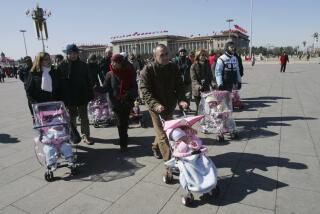China Improving Care of Abandoned Children
- Share via
BEIJING — Wu Teng was 12 before he could write a sentence.
Growing up in a state orphanage, Wu rarely saw the inside of a classroom. Two months ago he was moved to Hui Ling, a new foster care center in Beijing. Now he eagerly shows visitors how he is learning to use a computer.
“I like it better here. I don’t want to go back to the orphanage,” Wu said.
Homes like Hui Ling are part of changes sweeping the way China cares for its orphans--abandoned by the tens of thousands because of the one-child rule.
Since 1979, China has limited urban couples to one child and rural parents to two, if their first is a girl. With male heirs favored, parents sometimes abandon infant girls, or sons with serious illnesses or birth defects.
Not long ago, orphans were shunted to state institutions where abuse and neglect were so rife, foreigners called them “dying rooms.”
Now, new laws are providing better training and better homes as well as encouraging adoption among the Chinese, international aid workers say.
“There’s now a real sense of the need for change in the government. They’re trying to go beyond just providing food and shelter,” says Kate Wedgewood, Beijing director of London-based Save the Children.
Figures vary on how many orphans live under state care. The Chinese government counts 20,000 overall, in 73 large institutions and 1,200 smaller ones. Experts say the number is at least five times that.
Abandonment is a legacy of the one-child policy of population control. In the past, some human rights groups and journalists accused China of letting the weak and sick die. The allegations were generally dismissed by the Chinese and most foreign officials, but they stung, and China shut its orphanages to foreign reporters.
The Ministry of Civil Affairs, which manages China’s orphanages, refused requests from the Associated Press to visit an orphanage and speak to its officials.
Workers at international aid agencies, who asked not to be identified for fear of angering Beijing officials, say orphanages are still overcrowded, understaffed and underfunded. Nonetheless, they say, conditions are getting better, with improvements ranging from central heating and more beds to better care.
At the U.S. consulate in the southern city of Guangzhou, which approves all immigration visas for Chinese children going to U.S. parents, the 150-odd babies who pass through the office each week appear as healthy as American children, says consular officer Arlissa Reynolds. “We don’t see malnutrition or illnesses, beyond runny noses.”
Foreigners have played a large role in the reforms, both by adopting Chinese children and by building better facilities inside China. In the decade since China began allowing adoptions, foreigners have adopted 30,000 Chinese orphans, with Americans taking about three-quarters of them. Last year, 5,053 babies went to U.S. parents. A $3,000 fee for each adoption provides cash for Chinese foster care and orphanages.
Seven years ago, in southwestern Yunnan province, Save the Children built China’s first orphanage designed to replicate family life. The aid organization, which plans to build four similar homes, also distributes a Chinese-language training manual and video for establishing such facilities.
Hui Ling, the first such center in Beijing, was started last year by two social workers, one British, one Chinese. Overseen by housemothers, its six children live like a family, splitting household chores.
Wu Teng, who uses crutches because of a deformed right leg, arrived in November from a state orphanage in the neighboring city of Tianjin. Since then, he’s eaten his first restaurant meal and gone on frequent shopping trips.
Hui Ling leased a second house last year so six more children can be moved out of orphanages.
The government also wants Chinese citizens to adopt unwanted children. A law passed two years ago allows couples to adopt even if they have a child.
“Finding a permanent family in the home country is always the best option,” says Wedgewood of Save the Children.
More to Read
Sign up for Essential California
The most important California stories and recommendations in your inbox every morning.
You may occasionally receive promotional content from the Los Angeles Times.













